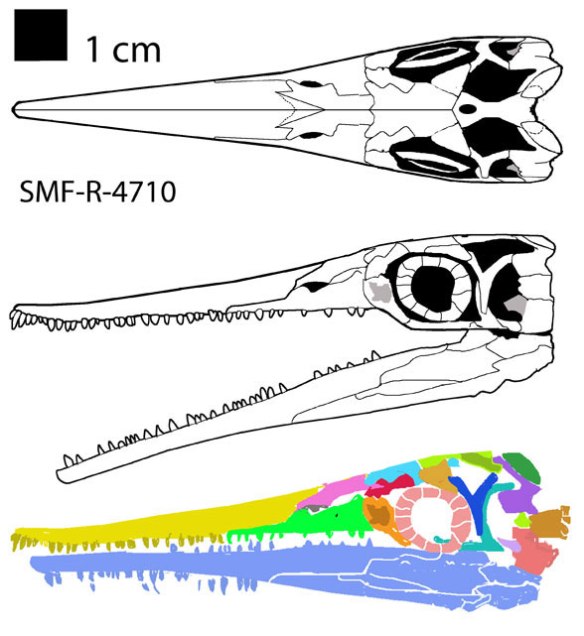Update on the Rossman 2002 “Brazilosaurus”

Figure
1. Click to enlarge. The nesting of Rossman’s “Brazilosaurus” (the
PIMUZ AIII 0192 specimen) at the base of the Thalattosauria is confirmed
with the addition of post-cranial and new cranial data.
Earlier the only data I had on this specimen was a line drawing of a skull from Rossman 2002. This data resulted in a nesting outside of Brazilosaurus + Stererosternum + Mesosaurus, at the base of the Thalattosauria. Notably, with the additional data, the nesting did not change.
Crushed skulls are often the best Because all the parts are crushed into a single plane and you can rebuild that “house of cards” or “crushed eggshell” in many views. Some parts are visible through the orbit. The occiput often flips to the side.
Mesosaurs are key
Workers have attempted to nest mesosaurs based on its lack of temporal fenestration — and they (Modesto 2006) end up with pareiasaurs and millerettids and procolophonoids. But with it’s hyper-long teeth, Mesosaurus is clearly a derived form. What we’re looking for is a basal taxon that looks like Mesosaurus with small plesiomorphic teeth. Then perhaps we’ll see more evidence for the diapsid skull morphology. And that’s exactly what we find.

Figure
2. Click to enlarge. The Rossman “Brazilosaurus” PIMUZ AIII 0192. This
turns out to be THE basal thalattosaur as well as a basal mesosaur. Due
to severe crushing elements from the other side of the skull made it
appear that the skull lacked fenestration following the generally
accepted but mistaken hypothesis that all mesosaurs lacked temporal
fenestra. Note the tiny forelimbs and deep tail chevrons. Low dorsal
spines and gracile ribs are also noteworthy.
Here (Fig. 1) the Rossman (2002) “Brazilosaurus” nests at
the base of the Thalattosauria, whether using the Rossman data as is, or
pulling slightly different traits out (Fig. 2).
Rossman (2002) presented photos of several interesting mesosaurs.
Among them was the SMF-R-4710 specimen attributed to Stereosternum (Fig.
3). This one does nest with Stereosternum, but with more open
temporal fenestrae, its nests at the base of the mesosaurs, close to the
base of the ichthyosaurs and thalattosaurs.

Figure
3. Click to enlarge. The SMF-R-4710 specimen attributed to
Stereosternum, but with larger temporal fenestrae, smaller teeth and
other distinct traits. The high unfused dorsal processes are also seen
on Hupehsuchus and Utatsusaurus.

Figure
3. Stereosternum SMF-R-4710 reconstructed from traced image (in color
below). Here temporal fenestration is clearly diapsid.
Running the large reptile tree with all temporal fenestration traits deleted recovers a single tree unchanged from the full character list tree. If anyone wants to come up with better data or a better tracing, please use specimen numbers.
There are so many specimens of mesosaurs
and so many variations and only three names for them (Mesosaurus, Brazilosaurus, Stereosternum). Someone needs to put it all together and catalog some of the important specimens (e.g. the holotypes). We’ll need new generic names for the specimens above.
If someone has a good photo of the Brazilosaurus holotype (Shikama and Ozaki 1966), please let me know.
References
Cope ED 1886. A contribution to the vertebrate paleontology of Brazil. Stereosternum tumidum, gen. et sp. nov. Proceedings of the American Philosophical Society 23(121):1-21.
Modesto S 2006. The cranial skeleton of the Early Permian aquatic reptile Mesosaurus tenuidens: implications for relationships and palaeobiology. Zoological Journal of the Linnean Society, 2006, 146, 345–368.
Shikama T and Ozaki T 1966. On a Reptilian Skeleton from the Palaeozoic Formation of San Paulo, Brazil” Transactions and Proceedings of the Palaeontological Society of Japan, New Series 64: 351–358.
Nenhum comentário:
Postar um comentário
Observação: somente um membro deste blog pode postar um comentário.